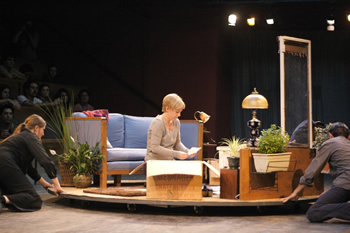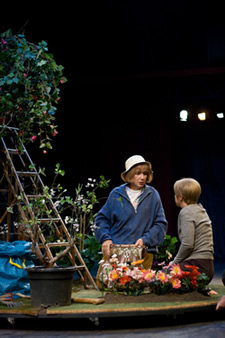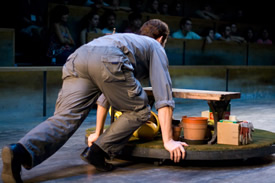
The Performance of Everyday Life
By Martin Harries
Les Éphémères
Created Collectively by Le Théâtre du Soleil
Directed by Ariane Minouchkine
The Park Avenue Armory
643 Park Ave.
Box office (Lincoln Center Festival): 212-721-6500
In August, 1922, the Parisian newspaper
L'Intransigeant posed a question to a group of celebrities:
An American scientist announces the end
of the world, or at the very least the destruction of such a
large land mass, and in such a sudden fashion, that death would
be the certain for hundreds of millions of people. If this prediction
were to become a certainty, how do you think that people would
behave between the time when they acquired this news and the
moment of apocalypse? And what would you do before the final
hour?
Marcel Proust responded:
Life would suddenly seem wonderful to
us if we were threatened to die as you say. Just think of how
many projects, travels, love affairs, studies, it--our life--hides
from us, made invisible by our laziness which, certain of a
future, delays them incessantly.
But let all this threaten to become impossible
for ever, how beautiful it would become again! Ah! if only the
cataclysm doesn't happen this time, we won't miss visiting the
new galleries of the Louvre, throwing ourselves at the feet
of Miss X, making a trip to India.
The cataclysm doesn't happen; we don't
do any of it, because we find ourselves back in the heart of
normal life, where negligence deadens desire. And yet we shouldn't
have needed the cataclysm to love life today. It would have
been enough to think that we are human and that death may come
this evening.
Both the Question and Proust's answer appear
in the program for the Le Théâtre du Soleil's Les Éphémères.
They form the perfect epigraph for an intensely engaging and exhilarating
day in the massive drill hall of the Park Avenue Armory. The twenty-nine
scenes of Les Éphémères oscillate between cataclysm and
an exacting, mesmerizing attention to the pleasures of everyday
life.
A family comes home from a fair. Two women,
one of them pregnant, and a man carry three children to a room
with a battered bunk-bed and an old cot. Each child carries a
candy apple and a plastic bag of goldfish. The adults heave one
child into the upper bunk, one into the lower. Awkwardly jammed
in with the third of the children, the man falls asleep at the
foot of the cot. The two women put the apples aside and gingerly
gather all the goldfish in one bowl. In the kitchen, they quietly
agree that, even though they have spent the last of their money,
the escapade was worth it. The phone rings. A winch has injured
a man. The pregnant woman wakes up her husband; he drinks cold
coffee and heads out in a rush to meet a boat at a dock in forty-five
minutes. The other woman drives him to the boat. Suddenly alone
in her quiet home, the pregnant woman cleans up and switches on
her radio to listen to a monotone broadcast of sea conditions.
 By
no means the most extraordinary of the play's many scenes, this
episode nevertheless typifies the sense of everyday life under
threat that characterizes the whole piece. One of those three
children lives temporarily in this home because her mother has
left her with friends; her mother has had to resort to a shelter
to escape an abusive husband. Similar constitutions of alternative
families in the wake of death, divorce, domestic and state violence
are a motif of the piece. And that deadpan voice on the radio
transmitting news about dangerous waters is one of the play's
many incarnations of an officialdom that alternately protects
and harasses these citizens. (One of the things this state owes
its citizens is information about how they might die.)
By
no means the most extraordinary of the play's many scenes, this
episode nevertheless typifies the sense of everyday life under
threat that characterizes the whole piece. One of those three
children lives temporarily in this home because her mother has
left her with friends; her mother has had to resort to a shelter
to escape an abusive husband. Similar constitutions of alternative
families in the wake of death, divorce, domestic and state violence
are a motif of the piece. And that deadpan voice on the radio
transmitting news about dangerous waters is one of the play's
many incarnations of an officialdom that alternately protects
and harasses these citizens. (One of the things this state owes
its citizens is information about how they might die.)
It's important that these theatrical subjects
are, with significant and poignant exceptions, French citizens.
If the last of the Théâtre du Soleil's productions in New York,
Le Dernier Caravansérail, staged the horrific journeys
of stateless persons, Les Éphémères concentrates on the
lives of those privileged enough to take for granted that the
state owes them care. Even the most painfully eccentric and comic
character, Perle (brilliantly portrayed by Shaghayegh Beheshti),
demands her rights when she is in the hospital, and two nurses
cooperatively figure out how to do their job while appearing to
cater to her desires.
At times the piece seems a meditation on
the value and fragility of the welfare state. Doctors, medics
at the scene of a car crash, a judge, a retired teacher, a state
archivist whose diligence effectively launches the central plot
of the play's second half: Les Éphémères has a deep sympathy
for those who seek to maintain the structures of everyday life.
"I love my job!" declares the archivist, and that love is palpable.
It is probably no coincidence that, as
its web site notes, the Théâtre du Soleil is now giving its own
archive to the National Library of France. Les Éphémères
is itself a kind of archive. As in the best collages, the conjunctions
of objects on stage seem at once accidental and inevitable. Every
object, from kitschy sculptures to board games to toys, resonates.
Sometimes such resonance approaches a kind of symbolism. When
an old couple's grandson pounds desperately on their door in need
of cash for his next fix, the needles in a knitting basket take
on a sinister aspect. More playfully, when a child strikes up
an unlikely friendship with a cross-dressing man, the package
for a board game called "Perdspaslaboule" (literally, "Don't lose
the ball"; figuratively, more or less, "Don't flip out") offers
its own commentary: it also bears the phrase, "gay-play." (This
seems to be the manufacturer.)
The resonance of these objects is, however,
less a matter of such verbal or visual puns than part of the piece's
militant dedication to the lived surround of everyday lives. Many
of the episodes have plot ties to other episodes; many don't.
And in some ways it is this second group of unconnected scenes
that seem truest to the spirit of Les Éphémères. Just
as the objects do not need to symbolize something larger than
themselves, so these isolated scenes do not become important because
they contribute to some more expansive and putatively more significant
plot.
Les Éphémères demonstrates just
how hard it is to achieve some convincing simulacrum of everyday
life. Seated on two banks of opposing bleachers, the audience
can watch itself. The apparatus on which these scenes appear --
the round platforms on casters pushed by actors who remain always
visible and always visibly attentive -- produces its own forms
of grace and athleticism, and one can find oneself watching those
pushing the platforms instead of those involved with the action
of a given scene. So how is it that the piece succeeds in conveying
that sense of the everyday?
 Proust's
answer might be that the threat of cataclysm makes life visible.
Evidently the company's exercises for Les Éphémères first
took their impetus from the challenge of staging possible responses
to the imminent end of the world. But this apocalyptic strand
disappeared in the long rehearsals and preparations for the piece.
Proust's general cataclysm disappears in the more familiar disruptions
of car accidents, divorce, drug addiction, and in the threats
of storms of other kinds. As this list suggests, such stories
are hardly unfamiliar, and indeed the stuff of soap operas and
melodrama.
Proust's
answer might be that the threat of cataclysm makes life visible.
Evidently the company's exercises for Les Éphémères first
took their impetus from the challenge of staging possible responses
to the imminent end of the world. But this apocalyptic strand
disappeared in the long rehearsals and preparations for the piece.
Proust's general cataclysm disappears in the more familiar disruptions
of car accidents, divorce, drug addiction, and in the threats
of storms of other kinds. As this list suggests, such stories
are hardly unfamiliar, and indeed the stuff of soap operas and
melodrama.
In the second of the piece's two parts,
however, one plot comes to seem the central story of Les Éphémères,
and it involves a cataclysm so overwhelming as to threaten to
obscure the scenes that are not part of this plot: Jeanne Clément,
played with a traumatized but open-eyed calm by Delphine Cottu,
discovers that her grandparents, about whom her mother had told
her nothing, were deported to Auschwitz. Scenes show the granddaughter's
search as well as reconstructions of what she has found. So this
piece so dedicated to the presentation of compelling fragments
of everyday life culminates in a genocidal cataclysm that spelled
the end of that life for millions.
By remaining true to its aesthetic of the
everyday, Les Éphémères mostly escapes the portentousness
that can come from folding stories and episodes into the Holocaust's
closure of all closures. While a certain composite halo begins
to surround the several saintly characters played by Juliana Carneiro
da Cunha--including a doctor with a heart of gold who befriends
the crazy Perle and the woman who protects Clément's mother from
the Nazis--the play never forgets the complexities to which it
has been dedicated. No simple historical allegory with its heroines
and villains makes over what has transpired in its image.
The company's dedication to the value of
the transient and fleeting, to "les éphémères" in many manifestations,
means that critical discourse feels more than usually out of step
with the experience to which it tries to do justice. Maybe, all
the same, one can point. One can point to a mode of attention
produced in a certain theater, over seven hours or so: a mode
of attention that, for once, requires no cataclysm to achieve.
